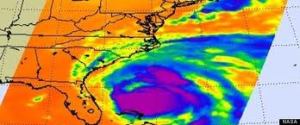 The eye of Hurricane Irene is approaching Virginia Beach as I write. Here in New York City, there’s an eerie calm. So far, although it’s overcast, it’s barely raining. It’s literally the calm before the storm.
The eye of Hurricane Irene is approaching Virginia Beach as I write. Here in New York City, there’s an eerie calm. So far, although it’s overcast, it’s barely raining. It’s literally the calm before the storm.
One of the most bizarre aspects of all this, in fact, is the uncertainty. What will the storm really be like? Will its strength diminish or increase after it hits landfall in the Carolinas and then heads back out to sea and towards NYC? Will it swerve away or continue straight on its projected route, dead-on towards New York City?
However one regards such questions, Hurricane Irene is already a landmark event in the natural history of the city. Parts of the city, including my neighborhood of St. George in Staten Island, have already been evacuated for the first time in the city’s history.
I’m staying in Jackson Heights, Queens. A few hours ago, I went out to buy some groceries. As predicted, the stores were packed with people buying everything off the shelves. But there was a surreal air. At the entrance, a guy was talking on a cellphone, saying in an amused voice that it was like the end of the world was coming in the store. It was crowded, and nerves were definitely on edge (one of the first things I saw was two guys arguing over a loaf of bread), but there were no flesh-eating zombies or anything. Stores are beginning to board up their windows, but there’s still an air of calm, with lots of people walking around shopping and lots of cars in the streets.
Last night there was an animation on TV that looked just like the computer graphic used by Al Gore to illustrate the impact of climate change in An Inconvenient Truth:
[youtube=http://www.youtube.com/watch?v=fRTsg_998eU]
This shocking image of submersion, with the implication of potential loss of life and certain loss of billions of dollars in storm-related damage, really underlines the folly of the present moment.
Take one example: I’ve been blogging recently about the Keystone XL Tar Sands pipeline, which is slated to open up one of the largest remaining unexploited troves of fossil fuels on the planet. Yesterday the State Department finalized an environmental review that found that the pipeline posed limited risks to the environment. There’s lots of controversy about this given the thin gauge of the pipeline and the history of accidents. Yet, even more glaring than this, is the absolute folly of arguing that the pipeline poses limited risks to the environment in a year in which environmental disasters, from droughts to floods to blizzards, have caused more damage in the U.S. than in any previous year on record. How ironic that a wing of the U.S. government should issue such a report just as a massive hurricane was barreling towards Washington, D.C. One could hardly hope for a clearer image of the government and the political elite keeping its collective head in the sand.
But is this really what they are doing? There’s lots of money to be made from disasters, as Naomi Klein demonstrated so powerfully in The Shock Doctrine. My friend Christian Parenti’s recent book Tropic of Chaos offers an unnerving series of snapshots of the ways in which elites in the U.S. and around the world are approaching climate chaos.
How this impacts the average person, including the denizens of New York City, on which Nature seems to have painted a giant bull’s eye, remains to be seen.